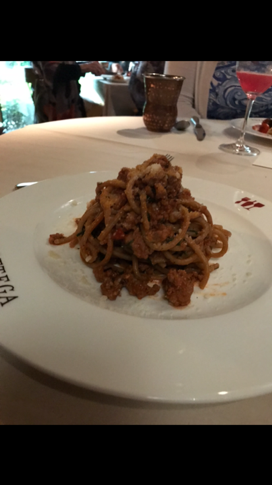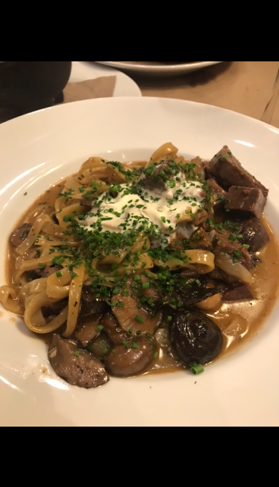Portions Within the Restaurant Industry
Students in Steve Finn’s spring special topics course on Food Waste (MET ML702 E1) are contributing this month’s blog posts. Today’s post is from Victoria Collins.
Many individuals are aware of the food waste issue in some capacity. Whether you tend to purchase a bit more groceries than you need each week, take more than you need at a buffet, or you’re one of those people who tend to make way more food than necessary during a family gathering in fear that there won’t be enough; many of us can relate to food waste guilt. One issue that particularly interests me is food waste within the restaurant industry. It may come as a surprise that those in the professional food industry still contribute to the food waste issue. Looking back at my camera roll, I noticed a huge difference in portion size depending on which restaurants I took photos at. I was particularly intrigued by a side by side pasta photo collage, pictured below. The photo on the left was taken at Michael Chiarello’s Napa Valley restaurant, Bottega. The photo on the right was taken at Gibbet Hill Grill, in Groton, MA.


Both of these were delicious pasta dishes at a comparable price, made with quality ingredients. The major difference, as you can see for yourself, was the portion size. The pasta dish at Bottega probably aligns with the actual recommended serving size of pasta. It featured such a rich and decadent veal Bolognese sauce, that the small portion was fitting for the sauce and ended up being very filling. On the opposite spectrum, the pasta dish at Gibbet Hill Grill was very large and almost impossible to finish in one sitting. It was a delicious beef stroganoff pasta dish with meaty mushrooms and earthy chives throughout. The sinful yet delicious sauce was so filling on its own, that the massive amount of pasta paired with it, made it truly too large of a dish to eat. I took half of it home because who doesn’t like delicious leftovers the next day? Unfortunately, I noticed that many people in the restaurant were allowing for the waiting staff to clear their plates with a lot of uneaten food left on their plates.
According to The State of Food and Agriculture: Moving Forward on Food Loss and Waste Reduction, written in 2019, “Food waste is the result of purchasing decisions by consumers, or decisions by retailers and food service providers that affect consumer behavior” (4). If food waste can be improved upon through both the consumer and the food service provider, we can attack the issue from various angles. One way that both the consumer and food service provider can help to reduce food waste is through portion control. Restaurants can provide portion options to their customers. This would benefit the consumer through a decrease in price and through food waste control. Offering customers either a half portion or full portion is a great solution to cutting back on excess food waste. If an individual enters a restaurant and wants a lot of pasta or a full sized salad, they have the option to order that specific size. On the flip side, if someone isn’t as hungry and wants something a bit smaller, they can reduce their spending cost as well as food waste. Some restaurants are already offering various portions but if we extend this across the board, I believe we can significantly reduce food waste within the restaurant industry.
Another idea for restaurants is to promote doggy bags and taking excess food home. If restaurants automatically assume that their customers would like to box up their extra food, they are doing their part in helping to reduce food waste. I have been to many restaurants where they automatically take your plate when they assume you are finished with your food. They skip over the step of asking you if you would like to take the rest home. If more restaurants promote this type of behavior, customers will start to assume that anything they don’t finish will be boxed up for them to take home. Even something as simple as the extra bread at the table can be boxed up and taken home for the next morning’s breakfast toast or a late night vehicle for a grilled cheese. These simple recommendations can help to improve our fight against food waste and also create a more mindful atmosphere surrounding food in restaurants.